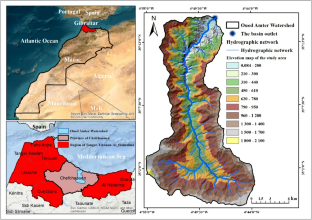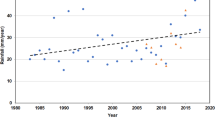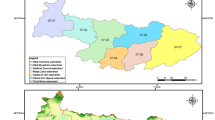Abstract
Sustainable development is threatened by soil erosion. Since it takes over 300 years for a centimeter of soil to form, preventing soil erosion is essential to safeguarding priceless resources. In any hydrological analysis, morphometric analysis is a relevant scientific method that is essential to the development and management of drainage basins. The main objectives of this study were (i) to analyze the morphometric parameters of the Oued Amter Basin using geographic information systems (GIS) and remote sensing (RS) (geospatial tools) and (ii) to prioritize sub-basins and identify the major morphometric parameters that influence soil erosion in the Oued Amter Basin. Morphometric analysis of the Oued Amter Basin (300 km2) was performed to prioritize sub-basins based on their susceptibility to erosion by water using geospatial tools (remote-sensing-based data and a GIS). The linear, relief, and shape morphometric parameters of the drainage network were calculated using data from the Advanced Land Observing Satellite (ALOS) phased-array L-type synthetic-aperture radar (PALSAR) digital elevation model (DEM) with a spatial resolution of 12.5 m. These parameters revealed the network’s texture, morpho-tectonics, geometry, and relief characteristics (including stream length (Lu) and mean stream length (Lsm), stream length ratio (RL), bifurcation ratio (Rb), average bifurcation ratio (RBM), drainage density (Dd), drainage texture (T), flow frequency (Fs), elongation rate (Re), circularity ratio (Rc), form factor (Ff), relief, and relief ratio). Using the array of compound (Cp) values that were computed, we set the priority ranks and divided the sub-watershed into four priority-rank groups: (i) low, which represents 5% of the basin surface; (ii) moderate, which represents 30%; (iii) high, which represents 35%; and (iv) extremely high, which represents 30% of the basin surface. The results show that this classification is valuable for prioritizing and planning interventions focused on addressing soil erosion and mitigating natural hazard risks within the watershed. The method tested here has been shown to be an effective tool to improve sustainable soil management.








Similar content being viewed by others
Abbreviations
- A :
-
Area of basin
- ASTER:
-
Advanced Spaceborne Thermal Emission and Refection Radiometer
- C :
-
Channel maintenance constant
- Cc:
-
Compactness coefficient
- Cp:
-
Compound values
- Dd:
-
Drainage density
- DEM:
-
Digital elevation model
- Dt:
-
Drainage texture
- Ff:
-
Form factor
- Fs:
-
Stream frequency
- GIS:
-
Geographic information system
- If:
-
Infiltration number
- km:
-
Kilometers
- km2 :
-
Square kilometers
- Lg:
-
Length of overland flow
- Lu:
-
Stream length
- Lsm:
-
Mean stream length
- N:
-
North
- Nu:
-
Stream number
- P :
-
Perimeter of basin
- QGIS:
-
Quantum GIS
- Rc:
-
Circularity ratio
- Re:
-
Elongation ratio
- Rb:
-
Bifurcation ratio
- RL:
-
Stream length ratio
- SBW:
-
Sub-watershed
- RS:
-
Remote sensing
- T :
-
Texture ratio
- u :
-
Stream order
- W:
-
Watershed
References
Ahmad Rather M, Satish Kumar J, Farooq M, Rashid H (2017) Assessing the influence of watershed characteristics on soil erosion susceptibility of Jhelum basin in Kashmir Himalayas. Arab J Geosci 10:59
Allen CG, Andres C, Sheldon ML (2001) Developing a geomorphic approach for ranking watersheds for rehabilitation, Zuni India reservation. New Mexico J Geomorphol 37(1–2):105–134. https://doi.org/10.1016/S0169-555X(00)00065-9
Angima SD, Stott DE, O’Neill MK, Ong CK, Weesies GA (2003) Soil erosion prediction using RUSLE for central Kenya highland conditions. Agric Ecosyst Environ 97:295–308
Arabameri A, Rezaei K, Cerda A, Lombardo L, Rodrigo-Comino J (2019) GIS-based groundwater potential mapping in Shahroud plain, Iran. A comparison among statistical (bivariate and multivariate), data mining and MCDM approaches. Sci Total Environ 658:160–177. https://doi.org/10.1016/j.scitotenv.2018.12.115
Arefin R, Mohir MMI, Alam J (2020) Watershed prioritization for soil and water conservation aspect using GIS and remote sensing: PCA-based approach at northern elevated tract Bangladesh. Appl Water Sci 10(4):1–19. https://doi.org/10.1007/s13201-020-1176-5
Arun PS, Jana R, Nathawat MS (2005) A rule based physiographic characterization of a drought prone watershed applying remote sensing and GIS. J Indian Soc Remote Sens 33(2):189–201. https://doi.org/10.1007/BF02990035
Astras T, Soulankellis N (1992) Contribution of digital image analysis techniques on Landsat-5 TM imageries for drainage delineation. A case study from the Olympus Mountain, west Macedonia, Greece. In: Proc 18th Annual Conf of Remote Sensing Society, Dundee, UK, 15–17 Sept 1992, pp 15–17
Bali YP, Karale RL (1977) A sediment yield index for choosing priority basins. IAHS AISH Publ 222:180
Bendjoudi H, Hubert P (2002) Le coefficient de compacité de Gravelius: Analyse critique d’un indice de forme des bassins versants. Hydrol Sci J 47(6):921–930. https://doi.org/10.1080/02626660209493000
Benzougagh B, Boudad L, Dridri A, Driss S (2016) Utilisation du Sig dans L’analyse morphométrique et la prioritisation ses sous-bassins versants de Oued Inaouene (Nord-Est du Maroc). Eur Sci J 12(6):266. https://doi.org/10.19044/esj.2016.v12n6p266
Benzougagh B, Dridri A, Boudad L, Kodad O, Sdkaoui D, Bouikbane H (2017) Evaluation of natural hazard of Inaouene Watershed River in Northeast of Morocco: Application of Morphometric and Geographic Information System approaches. Int J Innov Appl Stud 19(1):85
Benzougagh B, Meshram SG, Dridri A, Boudad L, Baamar B, Sadkaoui D, Khedher KM (2022) Identification of critical watershed at risk of soil erosion using morphometric and geographic information system analysis. Appl Water Sci 12:1–20. https://doi.org/10.1007/s13201-023-01963-w
Benzougagh B, Meshram SG, Fellah BE, Mastere M, El Basri M, Ouchen I, Sadkaoui D, Bammou Y, Moutaoikil N, Turyasingura B (2023) Mapping of land degradation using spectral angle mapper approach (SAM): the case of Inaouene watershed (Northeast Morocco). Model Earth Syst Env 10:221–231. https://doi.org/10.1007/s40808-023-01711-8
Bhatt S, Ahmed SA (2014) Morphometric analysis to determine floods in the Upper Krishna basin using Cartosat DEM. Geocarto Int 29(8):878–894. https://doi.org/10.1080/10106049.2013.868042
Bhattacharya A (2013) Evolution of the hydro-geonomic characteristics of flood in the Mayurakshi River basin of Eastern India. Doctoral dissertation. The University of Visva-Bharati, Shantiniketan, pp 24–82, 100–147. http://hdl.handle.net/10603/19911. Accessed 8 April 2017
Biswas S, Sudhakar S, Desai VR (1999) Prioritisation of subwatersheds based on morphometric analysis of drainage basin: A remote sensing and GIS approach. J Indian Soc Remote Sens 27(3):155–166. https://doi.org/10.1007/BF02991569
Chalouan A (1986) Les nappes Ghomarides (Rif septentrional, Maroc), un terrain varisque dans la chaîne alpine. Doctoral dissertation. Strasbourg 1, Strasbourg
Chandniha SK, Kansal ML (2017) Prioritization of sub-watersheds based on morphometric analysis using geospatial technique in Piperiya watershed, India. Appl Water Sci 7:329–338. https://doi.org/10.1007/s13201-014-0248-9
Chandrashekar H, Lokesh KV, Sameena M, Roopa J, Ranganna G (2015) GIS-based morphometric analysis of two reservoir catchments of Arkavati River, Ramanagaram District, Karnataka. Aquat Procedia 4:1345–1353. https://doi.org/10.1016/j.aqpro.2015.02.175
Clarke C (1966) Morphometry from maps. Essays in geomorphology. Elsevier, New York, pp 235–274
Didon J, Durand-Delga M, Kornprobst J (1973) Homologies géologiques entre les deux rives du détroit de Gibraltar. Bull Soc Géol Fr 7(2):77–105. https://doi.org/10.2113/gssgfbull.S7-XV.2.77
Didon J, Durand-Delga M, Esteras M, Feinberg H, Magné J, Suter G (1984) La Formation des Grès Numidiens de l'arc de Gibraltar s’intercale stratigraphiquement entre des argiles oligocènes et des marnes burdygaliennes. C R Acad Sci Paris 299(3):121–128.
Durand-Delga M (1972) La courbure de Gibraltar extrémité occidentale des chaînes alpines unit l’Europe et l’Afrique. Eclogae Géol Helv 65:267–278
Durand-Delga M, Lespinasse P (1965) Le Miocène des Beni-Issef (Rif septentrional) et ses rapports avec la nappe numidienne. C R Somm Soc Géol France 10:321–323
Durand-Delga M, Rossi P, Olivier P, Puglisi D (2000) Situation structurale et nature ophiolitique de roches basiques jurassiques associées aux flyschs Maghrébens du Rif (Maroc) et de Sicile (Italie). C R Acad Sci 331:29–38
Efthymiadis D, Goodess CM, Jones PD (2011) Trends in Mediterranean gridded temperature extremes and large-scale circulation influences. Nat Hazard 11(8):2199–2214. https://doi.org/10.5194/nhess-11-2199-2011
El Brahimi, M, Benzougagh B, Najia F (2022) Quantification of soil sensitivity to water erosion by the RUSLE model in the Oued Amter watershed, northwestern Morocco. Iraqi Geol J 55(2C):41–55. https://doi.org/10.46717/igj.55.2C.4ms-2022-08-17
Faniran A (1968) The index of drainage intensity—A provisional new drainage factor. Austral J Sci 31:328–330
FAO, F. Agriculture Organization of the United Nations (1970) Amino acid content of foods, 2
Fartas N, El Fellah B, Mastere M, Benzougagh B, El Brahimi M (2022). Potential soil erosion modeled with RUSLE approach and geospatial techniques (GIS tools and remote sensing) in Oued Joumouaa Watershed (Western Prerif-Morocco). Iraqi Geol J 55(2B):47–61. https://doi.org/10.46717/igj.55.2B.5Ms-2022-08-21
Gajbhiye S, Mishra SK, Pandey A (2013a) Prioritizing erosion prone area through morphometric analysis: An RS and GIS perspective. Appl Water Sci 4(1):51–61. https://doi.org/10.1007/s13201-013-0129-7
Gajbhiye S, Mishra SK, Pandey A (2013b) Prioritization of Shakkar River catchment through morphometric analysis using remote sensing and gis techniques. J Emerg Technol Mech Sci Eng 4(2):129–142
Gajbhiye S, Mishra SK, Pandey A (2014) Prioritizing erosion-prone area through morphometric analysis: an RS and GIS perspective. Appl Water Sci 4:51–61
Gravelius H (1914) Grundrifi der gesamten Gewcisserkunde. Band I: Flufikunde (Compendium of Hydrology, vol. I. Rivers). Goschen, Berlin
Gravelius H (1941) Flusskunde. Goschen’sche Verlagshandlung, Berlin
GSI (1985) Geological quadrangle map, Barddhaman Quadrangle (72P, 73 M). Geological Survey of India, Printing Division, Hydrabad
Heush B (1970) L’érosion du Pré-Rif. Ann Rech For Maroc 12
Horton RE (1932) Drainage basin characteristics. Trans Am Geophys Union 13:350–361. https://doi.org/10.1029/TR013i001p00350
Horton RE (1945) Erosional development of streams and their drainage basins: Hydrophysical approach to quantitative morphology. Geol Soc Am Bull 56:275–370
Iqbal M, Sajjad H (2014) Watershed prioritization using morphometric and land use/land cover parameters of Dudhganga Catchment Kashmir Valley India using spatial technology. J Geophys Remote Sens 3:115. https://doi.org/10.4172/2169-0049.1000115
IWD (2015) Annual flood report for the year 2015. Irrigation and Waterways Department (IWD), Govt of West Bengal, Kolkata. https://wbiwd.gov.in/uploads/anual_flood_report/ANNUAL_FLOOD_REPORT_2015.pdf. Accessed 8 April 2017
Javed A, Khanday MY, Ahmed R (2009) Prioritization of subwatersheds based on morphometric and land use analysis using remote sensing and GIS technique. J Indian Soc Rem Sens 37:261–274. https://doi.org/10.1007/s12524-009-0016-8
Kamp U, Bolch T, Olsenholler J (2005) Geomorphometry of Cerro Sillajhuay (Andes, Chile/Bolivia): comparison of digital elevation models (DEMs) from ASTER remote sensing data and contour maps. Geocarto Int 20(1):23–33. https://doi.org/10.1080/10106040508542333
Kouli M, Vallianatos F, Soupios P, Alexakis D (2007) GIS-based morphometric analysis of two major watersheds, western Crete, Greece. J Environ Hydrol 15:1–17
Kumar A, Jayappa KS, Deepika B (2011) Prioritization of sub-basins based on geomorphology and morphometric analysis using remote sensing and geographic information system (GIS) techniques. Geocarto Int. https://doi.org/10.1080/10106049.2011.606925
Leopold LB, Wolman MG, Miller JP (1964) The drainage basin as a geometric unit (Chap 5). In: Fluvial processes in geomorphology. WH Freeman and Co, San Francisco
Magesh NS, Jitheshlal KV, Chandrasekar N, Jini KV (2013) Geographical information system-based morphometric analysis of Bharathapuzha river basin, Kerala, India. Appl Water Sci 3(2):467–477. https://doi.org/10.1007/s13201-013-0095-0
Maji A (2007) Assessment of degraded and wastelands of India. J Indian Soc Soil Sci 55:427–435
Manu MS, Anirudhan S (2008) Drainage characteristics of Achankovil river basin, Kerala. J Geol Soc India 71:841–850
Markose Joseph V, Dinesh AC, Jayappa KS (2014) Quantitative analysis of morphometric parameters of Kali River basin, southern India, using bearing azimuth and drainage (bAd) calculator and GIS. Environ Earth Sci 72:2887–2903. https://doi.org/10.1007/s12665-014-3193-x
Mastere M (2011) L’aléa mouvements de terrain dans la province de Chefchaouen (Rif Central, Maroc): Analyse spatiale, et modélisation probabiliste multi-echelle. Doctoral dissertation. Université de Bretagne Occidentale, Brest. https://www.theses.fr/2011BRES2070
Meshram SG, Sharma SK (2017) Prioritization of watershed through morphometric parameters: A PCA-based approach. Appl Water Sci 7(3):1505–1519. https://doi.org/10.1007/s13201015-0332-9
Miller VC (1953) A quantitative geomorphologic study of drainage basin characteristics in the clinch mountain area, Virginia and Tennessee. Technical report no. 3, contract N6 ONR. Department of Geology, Columbia University, New York, pp 271–300
Nag SK, Chakraborty S (2003) Influence of rock types and structures in the development of drainage network in hard rock area. J Indian Soc Rem Sens 31(1):25–35. https://doi.org/10.1007/BF03030749
NATMO (2001) National atlas and thematic mapping organization, district planning map series (DST). Digital Mapping and Printed Division, Govt. of India, Kolkata
Pakhmode V, Kulkarni H, Deolankar SB (2003) Hydrological-drainage analysis in watershed-programme planning: A case from the Deccan basalt. India Hydrogeol J 11(5):595–604. https://doi.org/10.1007/s10040-003-0279-z
Pandey A, Chowdary VM, Mal BC (2004) Morphological analysis and watershed management using GIS. Hydrology J 27(3 & 4):71–84
Prakash K, Mohanty T, Pati JK, Singh S, Chaubey K (2017) Morphotectonics of the Jamini River basin, Bundelkhand Craton, Central India; using remote sensing and GIS technique. Appl Water Sci 7(7):3767–3782. https://doi.org/10.1007/s13201-016-0524-y
Prasannakumar V, Vijith H, Geetha N (2013) Terrain evaluation through the assessment of geomorphometric parameters using DEM and GIS: case study of two major sub-watersheds in Attapady, South India. Arab J Geosci 6:1141–1151. https://doi.org/10.1007/s12517-011-0408-2
Rai PK, Chandel RS, Mishra VN, Singh P (2018) Hydrological inferences through morphometric analysis of lower Kosi River basin of India for water resource management based on remote sensing data. Appl Water Sci 8:1–16. https://doi.org/10.1007/s13201-018-0660-7
Ritter DF, Kochel RC, Miller JR (1995) Process geomorphology, 3rd edn. WC Brown, Dubuque, p 539
Romshoo SA, Bhat SA, Rashid I (2012) Geoinformatics for assessing the morphometric control on hydrological response at watershed scale in the Upper Indus basin. J Earth Syst Sci 121(3):659–686. https://doi.org/10.1007/s12040-012-0192-8
Sabir M, Roose E, Machouri N, Naouri A (2002) Gestion paysanne des ressources naturelles dans deux terroirs des montagnes méditerranéennes du Rif occidental (Maroc). Bulletin Réseau Érosion 21:414–428
Schumm SA (1956) Evolution of drainage systems and slopes in badlands at Perth Amboy, New Jersey. Bull Geol Soc Am 67:597–646. https://doi.org/10.1130/0016-7606(1956)67%5b597:EODSAS%5d2.0.CO;2
Sharma SK, Gajbhiye S, Nema RK, Tignath S (2014) Assessing vulnerability to soil erosion of a watershed of tons river basin in Madhya Pradesh using remote sensing and GIS. Int J Environ Res Dev 4(2):153–164
Sharma T, Singh O (2017) Soil erosion susceptibility assessment through geo-statistical multivariate approach in Panchkula district of Haryana, India. Model Earth Syst Environ 3:733–753. https://doi.org/10.1007/s40808-017-0331-y
Singh AK, Kala S, Dubey SK, Rao BK, Gaur ML, Mohapatra KP, Prasad B (2014) Evaluation of bamboo-based conservation measures for rehabilitation of degraded Yamuna ravines. Indian J Soil Conserv 42(1):80–84
Smith KG (1950) Standards for grading texture of erosional topography. Am J Sci 248:655–668. https://doi.org/10.2475/ajs.248.9.655
Sreedevi PD, Subrahmanyam K, Ahmed S (2004) The significance of morphometric analysis for obtaining groundwater potential zones in a structurally controlled terrain. Environ Geol 47(3):412–420. https://doi.org/10.1007/s00254004-1166-1
Strahler AN (1957) Quantitative analysis of watershed geomorphology. Trans Am Geophys Union 38:913–920. https://doi.org/10.1029/TR038i006p00913
Strahler AN (1964) Quantitative geomorphology of drainage basin and channel networks. In: Chow VT (ed) Handbook of applied hydrology. McGraw Hill, New York, pp 4–76
Subba Rao N (2009) A numerical scheme for groundwater development in a watershed basin of basement terrain: A case study from India. Hydrogeol J 17(2):379–396. https://doi.org/10.1007/s10040-008-0402-2
Suresh M, Sudhakar S, Tiwari KN, Chowdary VM (2004) Prioritization of watersheds using morphometric parameters and assessment of surface water potential using remote sensing. J Indian Soc Remote Sens 32:249–259. https://doi.org/10.1007/BF03030885
Sutradhar H (2020) Assessment of drainage morphometry and watersheds prioritization of Siddheswari River Basin, Eastern India. J indian Soc Rem Sens 48(4):627–644. https://doi.org/10.1007/s12524-020-01108-5
Udaipur E, Singh PK, Yadav KK (2020) Assessment of surface runoff using ArcSWAT for Rela Watershed, Rajasthan, India. J Geogr Environ Earth Sci Int 24(10):23–32. https://doi.org/10.9734/jgeesi/2020/v24i1030260
Umair A, Syed AA (2014) Analysis of drainage morphometry and watershed prioritization of Romushi-Sasar catchment, Kashmir Valley, India using remote sensing and GIS technology. Int J Adv Res 2(12):5–23
Umrikar BN (2017) Morphometric analysis of Andhale watershed, Taluka Mulshi, District Pune. India Appl Water Sci 7(5):2231–2243. https://doi.org/10.1007/s13201-016-0390-7
Verstappen H (1983) The applied geomorphology. International Institute for Aerial Survey and Earth Science (ITC), Enschede
Yadav SK, Singh SK, Gupta M, Srivastava PK (2014) Morphometric analysis of Upper Tons basin from Northern Foreland of Peninsular India using CARTOSAT satellite and GIS. Geocarto Int 29(8):895–914
Acknowledgements
The authors extend their appreciation to the Deanship of Scientific Research at King Khalid University for funding this work through a large research group. Project group number: RGP. 2/422/44.
Funding
This research work was supported by the Deanship of Scientific Research at King Khalid University under grant number RGP. 2/422/44.
Author information
Authors and Affiliations
Corresponding author
Ethics declarations
Conflict of interest
The authors declared no potential conflicts of interest with respect to the research, authorship, and/or publication of this article.
Additional information
Responsible Editor: João Miguel Dias.
Rights and permissions
Springer Nature or its licensor (e.g. a society or other partner) holds exclusive rights to this article under a publishing agreement with the author(s) or other rightsholder(s); author self-archiving of the accepted manuscript version of this article is solely governed by the terms of such publishing agreement and applicable law.
About this article
Cite this article
El Brahimi, M., Mastere, M., Benzougagh, B. et al. Assessing soil erosion vulnerability through geospatial morphometric analysis in the Oued Amter Basin (Northwest Morocco). Euro-Mediterr J Environ Integr (2024). https://doi.org/10.1007/s41207-024-00493-4
Received:
Accepted:
Published:
DOI: https://doi.org/10.1007/s41207-024-00493-4




